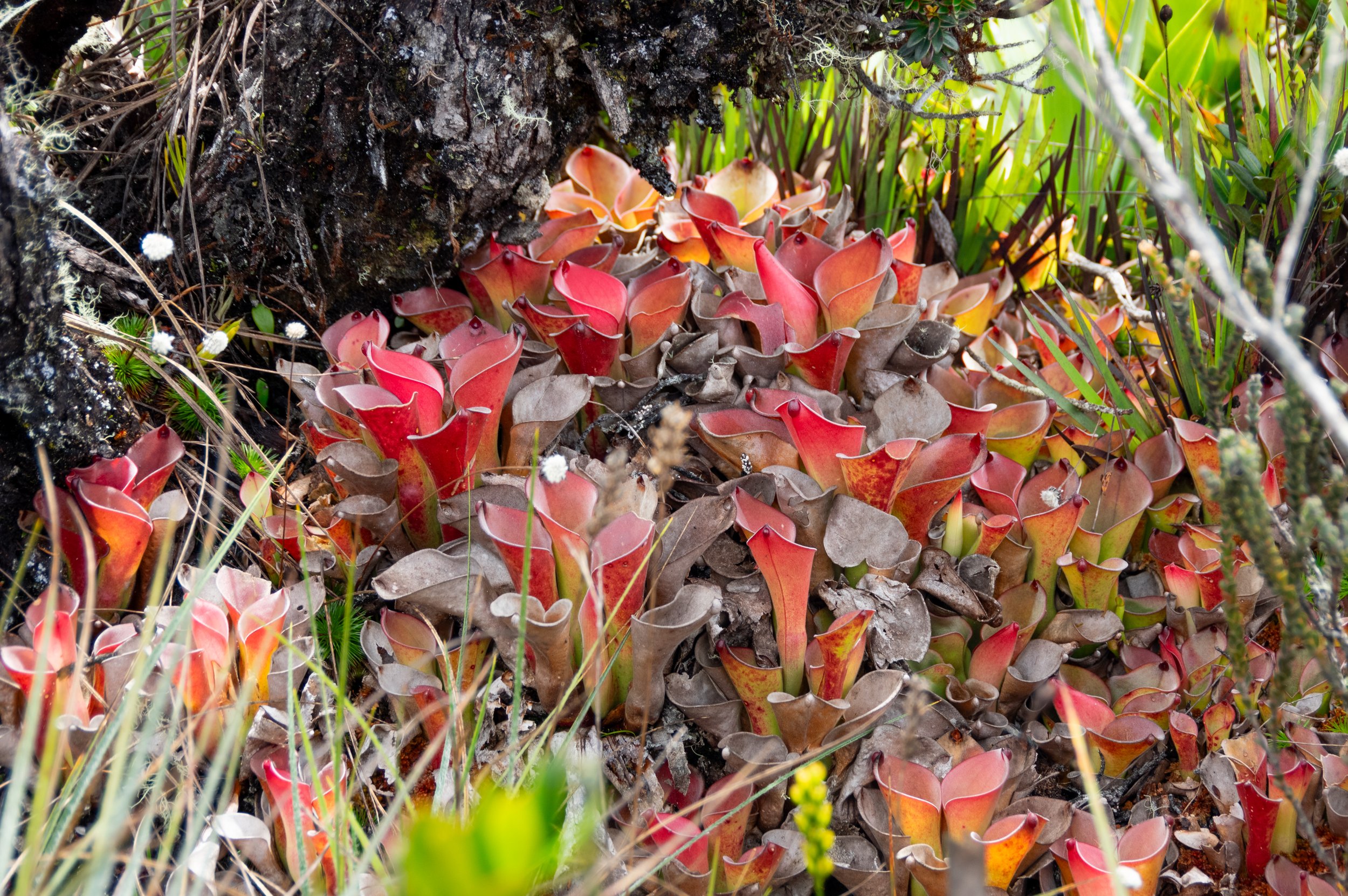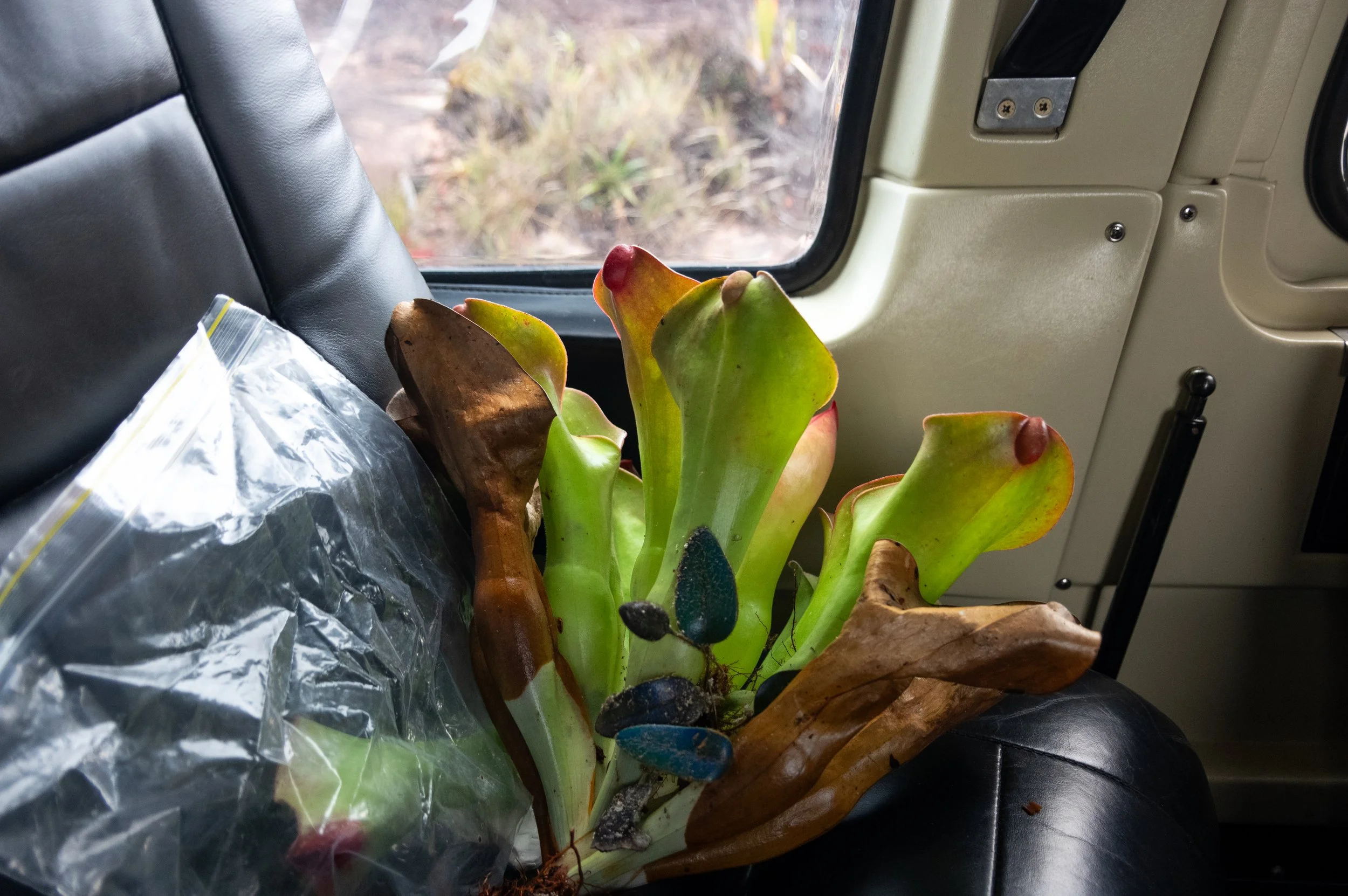
Aprada Tepui
Aprada Tepui is one of the most isolated, least visited, and difficult to reach tepuis. Standing at 8200 feet above sea level, Aprada sits between the Auyán and Chimantá Massifs, surrounded by jungle. It can only be accessed by helicopter, however the constant cloud cover makes the approach impossible except for brief moments when the sun burns a short-lived hole in the clouds. A unique variant of Heliamphora exappendiculata known as “Big Bubble” was reported from this tepui, exceptional for its giant bulbous nectar spoon. But given the minimal previous exploration, there could be other botanical wonders waiting as well.
Island in the Clouds
It had been nearly a week on the tepuis separated from the rest of the world. After a couple days on Chimantá, it was time to return by helicopter to the Pemón village down below the tepuis in the gran sabana. However, a plan was discussed late into the night to make a final, risky stop in search of one of the rarest forms of Heliamphora. This would take a special agreement with our helicopter pilot due to the dangerous flight and limited fuel. Instead of going back down, we would make a stop at Aprada Tepui.
Aprada is completely isolated from the other groupings of tepuis in the Auyán and Chimantá Massifs. Because of the vertical structure, it is almost always in clouds. Flying there requires incredible skill and luck to navigate through a hole in the clouds while landing on the rocky, uneven terrain. The conditions are best during midday when more of the clouds burn off, but this also meant we had to arrive and leave within a short 2 hour window. The pilot made very clear if anyone was not back on the helicopter at the time limit, they would be left behind.
The final Tepui
It may have only been 10 minutes to fly from Chimantá to Aprada, but the journey felt like an hour. Flying over the jungle below, Aprada protruded as a stone column surrounded by clouds. By pure luck, there was an opening in the clouds revealing the rough, weathered surface and a potential landing spot.
Our helicopter would wait here for exactly 2 hours while we explored the uncharted terrain. After that time, it would have to leave to avoid being stranded in the clouds. With only a daypack and no food (we had come straight from a week on other tepuis), timing and navigation was critical to find our botanical treasures.
The four of us naturally split up to explore the crevices and patches of vegetation, while still staying within visual distance of each other. After maybe 20 minutes we hadn’t found a single Heliamphora — but reassuring we reached an area with numerous, dense clusters of H. exappendiculata with lovely coloration. But these were small bubbles, not the giant we had come for.
The nectar spoon of Heliamphora exappendiculata is characteristically recessed below the rim of the pitcher. An ant is feeding on the visible nectar seeping from the nectar spoon, and could easily become prey. This however is a normal sized nectar spoon — we would still have to search for the “big bubble” variant hidden deep within this plateau.
Also within these islands of vegetation were some of the largest bladderwort flowers in the world. Utricularia humboldtii has the largest flowers of all carnivorous plants. These would usually grow within the water retaining bromeliads and agave-like plants, feeding on small aquatic creatures.
The landscape of this tepui contains deep rain-eroded crevasses with Bonnetia trees, bromeliads, and hopefully some carnivorous plants. While this tepui has a plateau only 1.69 square miles in area, the terrain and clouds make exploration slow and difficult.
The pockets of vegetation hidden in these cracks could be invisible until standing just feet away from the edge. This one contained an exceptional specimen of Utricularia humboldtii with some of the most colorful and largest flowers I saw on any tepui.
Within these slightly shaded pockets, dense clumps of Heliamphora exappendiculata could be found. Still we searched for the legendary giant bubble (nectar spoon) variant.
The edge of the plateau can be shrouded in clouds so you must always watch your step. These can drop off hundreds of feet without warning and visibility can go down to around 10-20 feet at times.
Typical Bubble
Big Bubble
Finally some larger bubbles (nectar spoons) on some specimens. Compare the left/first photo with the more typically sized bubble and the right/second photo with the large bubble. But these were not the largest we would find.
These are the legendary Heliamphora exappendiculata “Big Bubble” found only from this extremely isolated tepui. We only had around 30 minutes to explore this miniature canyon after climbing down maybe 25 feet of slippery cliffs.
These specimens were exceptionally large and growing out of an accumulation of spongey organic debris. These nectar spoons were giant. Note the Utricularia quelchii growing out of the moss and drippings at the underside of the tree trunk elevated in the background.
It is unclear how abundant this variant is — however others have seen it on this tepui before and it is in cultivation.
While photographing this area, we had to keep track of the time so we could navigate our way back to the helicopter before he left — with or without us onboard.
The tepuis feel quite devoid of animal life given their isolation, but this bird was found in this small ravine.
This incredibly specimen was taken for research to document this exceptional variant. These bubbles are gigantic as are the pitchers. Note the beautiful blue fern also collected for herbarium preservation. We had made it back to the helicopter, our mission successful. Now just to safely return to the world below…
This was one of several attempts to take off from the uneven terrain and ascend through a gap in the clouds. Flying into the clouds would result in zero visibility which is extremely dangerous due no visual reference to keep the helicopter oriented and the many cliffs in the area. We would take off, then sharply circle back to one of the only flat clearings to land again. This caused some nerves as the clouds were unrelenting.
This time the pilot accelerated past the edge of the cliff where there was no turning back. After a tense moment inside the cloud, we emerged into the sun.
Relief as we exit the clouds and can see the Chimanta Massif in the distance. The views are spectacular and truly display the transition from savannah to forested slopes to cliffs to flat, rocky plateau.
Expanses of dense jungle, rivers, and waterfalls still hold many biological secrets. Much of this area has never been explored, even by the indigenous Pemon people.
Landing in the village with the looming Akopan Tepui behind. We have returned from a week on the tepuis. From here our group would split up with only a few of us continuing on to climb the last ‘mountain’ of the trip — Auyan Tepui.






















